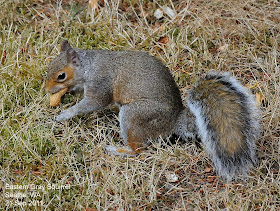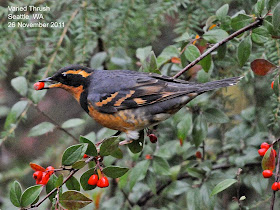You’ve doubtless seen the pigeons feeding in the city square
or along the freeways roosting on light standards and nesting under the
overpasses. These are Rock Pigeons (Columba
livia), formerly called Rock Doves, and they are native to Eurasia but have
been introduced all over the world, first as captive birds and then established
in cities, towns and the countryside outside of captivity. They are
rock-dwelling birds that nest on cliffs, and they see our city buildings and
barns as just another kind of cliff.
However, we also have a bona fide wild pigeon in the Pacific Northwest, the Band-tailed Pigeon (Patagioenas fasciata). These are birds of the forest, birds that roost in trees and not on buildings. They are common west of the Cascades, occasionally seen on the east side. Many migrate south in autumn, but good numbers persist through the winter in areas where they can find food, both wild and human-provided.
We are fortunate that Band-tailed Pigeons are easily
attracted to bird feeders with mixed seeds, as they are really quite attractive
birds. They look something like Rock Pigeons but are slightly
longer-tailed and rounder-winged, evident when they fly overhead. They are gray
above, with more reddish underparts and a dark band bordered by a pale tip on
the tail (thus the name). The bill and feet are bright yellow, and there is a
white half-collar on the neck with an iridescent patch of feathers behind it.
These pigeons are vegetarians with a varied diet. Their
range coincides with the range of oak trees throughout much of the West, and
they eat a lot of acorns. But they also take pine nuts, fruits of all kinds,
seeds of herbaceous plants, especially grains, and a variety of buds and
flowers.
Band-tails build flimsy nests of twigs well up in trees,
averaging about 10 meters but up to 50 meters above the ground. The nest is
usually on a firm limb not far from the trunk. They lay a single egg, quite
unusual among pigeons and doves, which usually lay two. The egg is incubated alternately
by both male and female for about 18 days to hatching.
Both parents produce “pigeon’s milk,” a curdlike substance
that sloughs off from the inner walls of the crop (production mediated by
prolactin, just as in mammalian milk!); this is unique to pigeons. The young bird
(“squab”) remains in the nest for three or more weeks and may be fed by the
adults after it fledges.
There has been an uptick of interest in Band-tailed Pigeons
in recent years. A group of researchers are committed to de-extinction of the
Passenger Pigeon (Ectopistes migratorius),
and they are moving rapidly toward that goal. Their method involves working out
the genomes of both species and the systematic replacement of Band-tailed
Pigeon with Passenger Pigeon genes: “converting viable Band-tailed DNA to
viable Passenger Pigeon DNA.” They have now fully sequenced both species, so
stay tuned!
On October 30, a juvenile Band-tailed Pigeon landed on the feeder right
in front of me, and it looked just enough like a Passenger Pigeon, not seen alive
for over a century, that a chill ran over me.
Dennis Paulson














4.jpg)





